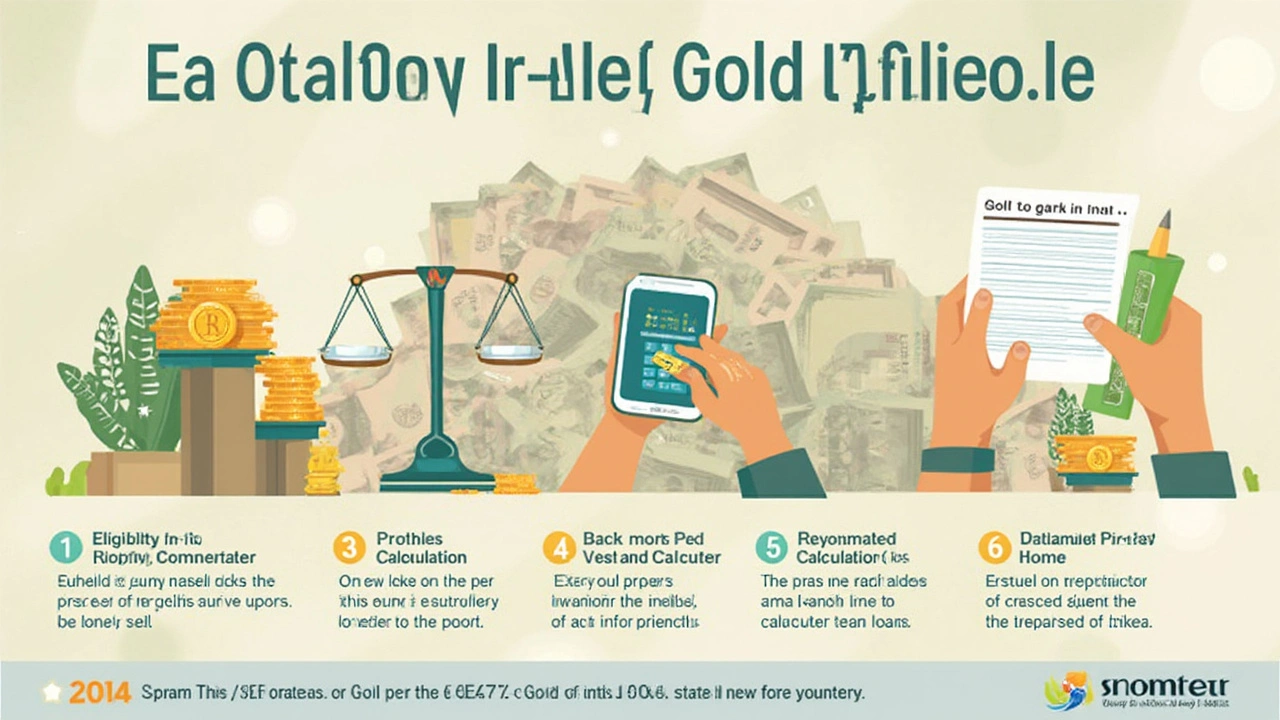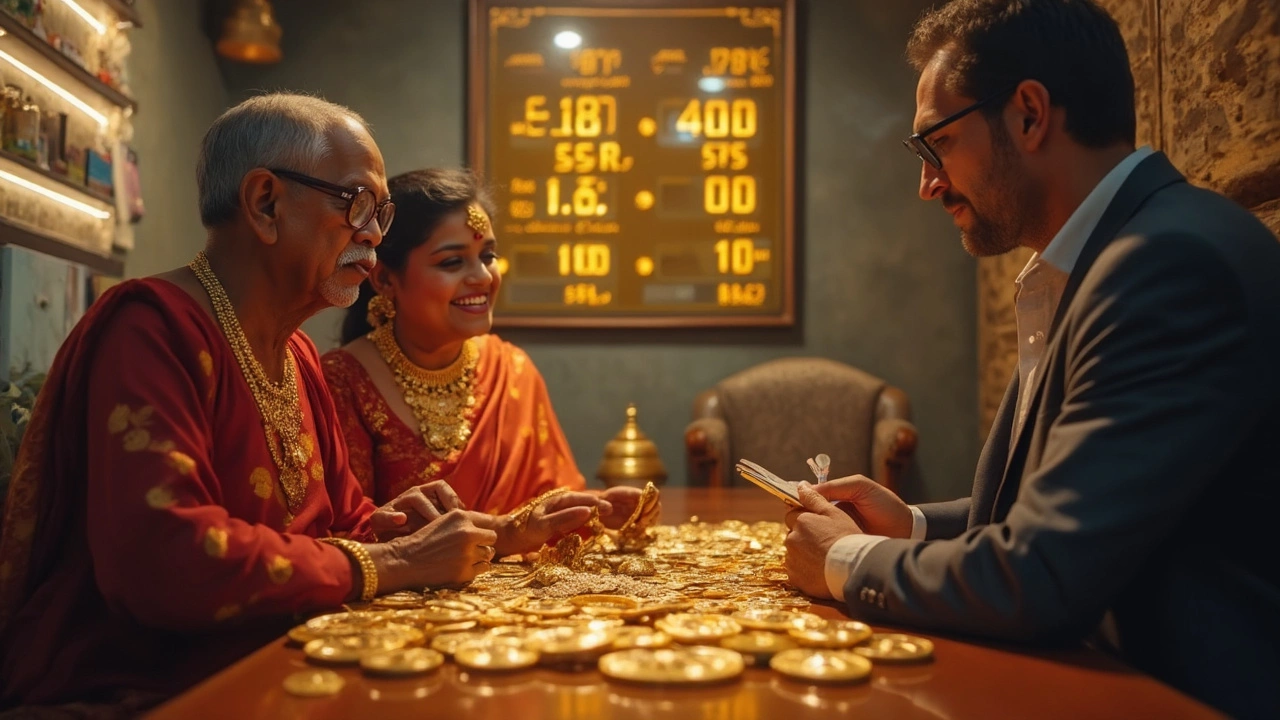If you're looking to borrow money by using your gold jewelry, the most common question is simple: how much loan can you get for 10 grams of gold? It's not a random guess—banks and lenders in India have set ways to figure it out, and rates can change every week (sometimes even daily) based on the gold price. Nobody wants to walk into a bank blind or get less than they could.
Here's the quick version: Most banks and NBFCs in India will lend you about 75% of the value of your gold. So if gold is selling at ₹6,800 per gram on April 18, 2025, then 10 grams is worth ₹68,000. You can usually get a loan of up to ₹51,000 for that amount of gold. But there’s a catch—different lenders may have slightly different percentages and rules, based on their risk appetite and the gold purity.
Want a better deal? The purity and form of your gold matter a lot. For example, 22-karat jewelry fetches more than a 20-year-old bangle with stone settings. Some lenders even run their own checks to confirm purity before giving a final loan amount. And yes, government banks usually offer more transparent deals than small local pawn shops, so always check with multiple lenders.
- What Decides Gold Loan Value?
- Typical Amount You Get for 10 Grams
- Top Banks and Lenders: What They Offer
- Smart Ways to Maximize Your Loan
- FAQs and Quick Tips
What Decides Gold Loan Value?
So how do banks and finance companies actually decide how much loan you're going to get for your gold? It isn’t just about walking in with a bracelet and expecting a set amount. Several boxes need to be checked, and lenders don’t skip their homework.
Let’s break it down. The main things that set the gold loan per 10 gram amount:
- Purity of Gold: This is big. Most lenders want 18K to 22K gold. That means the purer your gold, the higher the value. If there are stones, mixed metals, or it’s below 18K, don’t expect top rates.
- Current Gold Price: Lenders check the daily gold price set by market rates or the Indian Bullion Association. Rates can swing 2-4% in a week, so time your loan smartly.
- Loan-to-Value (LTV) Ratio: Most lenders in India stick to the RBI’s limit—currently, you’ll get up to 75% of your gold’s current value.
- Gold Weight (Net): Only the gold part counts. If your jewelry has stones or is hollow, banks deduct that before calculating your loan offer.
- Lender’s Terms: Some lenders give you more flexible rates or push the LTV limits, based on their risk policies or ongoing offers.
To make it ultra clear, here’s what a few banks are following right now (as of April 18, 2025):
| Lender | Purity Accepted | LTV Ratio | Gold Loan per 10 Gram* (₹) |
|---|---|---|---|
| State Bank of India | 21-22K | 75% | ₹50,700 |
| HDFC Bank | 18-22K | 75% | ₹50,500 |
| Muthoot Finance | 19-22K | 75% | ₹51,000 |
*Example based on ₹6,800 per gram market rate on April 18, 2025.
Here’s a quick heads-up: Gold coins and bars are sometimes accepted but only to a set weight (usually not more than 50 grams per borrower from banks). Always ask if your lender counts only jewelry or also accepts coins and bars.
Checking these basics before heading to the bank can honestly save you time, stress, and a few thousand rupees. Compare terms, check the gold price for the day, and don’t forget—never settle for what the first shop or bank offers without checking around.
Typical Amount You Get for 10 Grams
The big question—how much gold loan per 10 gram—has a straight answer, but there are a few things to keep in mind. On April 18, 2025, the market price of gold in India is around ₹6,800 per gram, according to leading bank rate sheets. So, 10 grams equals ₹68,000 in value. But you won’t get the full amount in your hand.
Following RBI rules, banks and most NBFCs cap the loan-to-value ratio (called LTV) at 75%. This means you’ll get up to 75% of the total value of your gold. Here’s a simple breakdown:
| Gold Weight | Market Price per Gram | Total Value | Maximum Loan (75% LTV) |
|---|---|---|---|
| 10 grams | ₹6,800 | ₹68,000 | ₹51,000 |
This gold loan per 10 gram ratio is common across big lenders like SBI, HDFC Bank, Manappuram, and Muthoot. Some banks may offer a little less if gold purity is below 22 karat or if your jewelry has a lot of stones or other metals mixed in.
Actual disbursement might be a tad lower after deductions like processing fees or taxes. Make sure to verify the current gold rate—they update it daily or sometimes more often.
Here's how lenders usually figure out your loan amount:
- Check purity—loans are mostly based on 18 to 22-karat gold
- Weigh only the gold, not stones or non-gold elements
- Apply the latest gold rate (per gram)
- Multiply by 75% (the standard LTV cap)
If you hand over simple 22-karat jewelry weighing 10 grams, expect a loan very close to that ₹51,000 mark. With older or lower-karat pieces, the offer might drop.
Quick tip: Always ask for the market price the bank is using that day and compare offers from at least two lenders before you decide where to pawn your gold.

Top Banks and Lenders: What They Offer
Lenders across India compete hard to win over gold loan customers. The differences aren't just in the loan amount—they also pop up in interest rates, loan tenure, processing fees, and small rules that could matter big time when money is tight. If you’re comparing options, looking at the offers from the top banks and NBFCs is smart.
Check out this quick breakdown on gold loan per 10 gram offered by major players as of April 2025, assuming the standard 22-carat gold value:
| Lender | Loan-to-Value (LTV) Ratio | Interest Rate Range (per year) | Processing Fees |
|---|---|---|---|
| SBI Gold Loan | Up to 75% | 8.5% – 11% | 0.5% (min ₹500) |
| HDFC Bank | Up to 75% | 9.0% – 14.5% | 1% (min ₹300) |
| Axis Bank | Up to 75% | 8.9% – 16% | 1% (min ₹500) |
| Muthoot Finance | Up to 75% | 10% – 24% | Starts at 0.5% |
| Manappuram Finance | Up to 75% | 12% – 27% | 0.25% – 1% |
Most of them cap their gold loan per 10 gram at the RBI limit—so that’s up to 75% of gold’s current market value. This means ₹51,000 for every 10 grams (at ₹6,800 per gram) is usually the maximum, but the actual amount can dip if your gold isn’t pure 22-carat or if it's old jewelry with a lot of stones.
You also want to pay close attention to the interest rate. Government banks like SBI and Bank of Baroda tend to offer lower rates and are seen as more reliable, compared to NBFCs like Muthoot or Manappuram, who might approve loans faster but often at a higher rate. These interest rates might look close on paper, but the difference really adds up over 12 months or more.
Processing fees can sneak up on you, too. Usually, it’s a percentage of your total loan and almost always non-refundable—even if you pay off the loan early. If you’re short on cash, every rupee counts, so don’t forget to ask if there are hidden charges for valuation, late payment, or foreclosing the loan before the end of the tenure.
Tip: Always get a written quote or use the gold loan calculator most banks offer online. This helps you figure out exactly how much you’ll get, and how much you’ll pay back, before you hand over your gold.
Smart Ways to Maximize Your Loan
If you're serious about making the most out of your gold loan per 10 gram, some basic moves can really boost your offer. Here’s what actually matters when you walk in with your jewelry.
- Pick High-Purity Gold: Lenders pay extra attention to the purity of your gold. 22-karat (or higher) gold always gets a better offer than anything below 20-karat. If you have BIS-hallmarked jewelry, wave that around—it’s the gold standard (literally) for trust.
- Avoid Stones and Mixes: Gold jewelry with stones, enamel, or even heavy soldering loses value during evaluation. Only the net gold weight counts for the loan—stones and alloys don’t matter. If possible, use plain gold items.
- Compare Loan-to-Value Ratios (LTV) Across Lenders: The maximum you can get is usually 75% of your gold’s value, thanks to RBI rules. But some banks might give slightly better offers, seasonal rate boosts, or waive processing fees. It always pays to check rates at a few places before you decide.
- Negotiate Processing Fees: Banks and NBFCs love to add a "processing fee” (around 1-2% of your loan amount) and sometimes throw in valuation charges. If you’re a repeat customer or have a good relationship with the branch manager, just ask them to cut this down. You’d be surprised how often this works.
- Check for Special Offers: Around festivals like Akshaya Tritiya or Diwali, lenders roll out discounts or slightly increase their gold loan per 10 gram rates. These promos aren’t a myth—you can grab a better deal if you time it right.
Here’s a quick comparison table to show what different banks and NBFCs usually offer for 10 grams of gold:
| Lender | Loan Per 10 Grams (₹) | LTV Ratio | Processing Fee |
|---|---|---|---|
| State Bank of India (SBI) | ₹50,500 | 75% | 1% or min ₹500 |
| Muthoot Finance | ₹51,000 | 75% | 1% or min ₹250 |
| ICICI Bank | ₹50,600 | 75% | 1-2% or min ₹500 |
| HDFC Bank | ₹50,800 | 75% | 1% or min ₹600 |
One last thing—always check repayment flexibility. Some lenders let you pay interest monthly and principal at the end, giving you a lighter start. Using all these tricks gives you a better shot at the highest gold loan per 10 gram possible, without any nasty fee surprises.

FAQs and Quick Tips
Ever been confused by how gold loans work, or just want to make sure you get the best deal? Here are answers to the common questions people have when it comes to gold loan per 10 gram in India, plus some easy tips to avoid rookie mistakes.
- How fast can you get cash? For most lenders, you walk in with your gold and ID, fill out a quick form, and if everything checks out, you can walk away with money in 30-45 minutes. Banks might take a bit longer but offer better transparency and paperwork.
- Is my gold safe? Reputed banks and top NBFCs keep your gold in highly secure vaults. You’ll get it back when you repay the loan. Always get a receipt describing your gold’s weight and quality before handing it over.
- Can you repay early? Yes, you can close your gold loan anytime. Most lenders charge simple interest, so the sooner you pay, the less you’ll owe. Some banks don’t even have prepayment penalties.
- How’s the eligibility decided? Basically, anyone with gold jewelry (usually 18K and up) and a basic ID proof can apply. Some private banks might ask for extra KYC, but most keep it simple.
- Is there a risk of losing my gold? If you completely ignore repayment for months, yes. Lenders usually send reminders for overdue amounts. If you still don’t pay, they could auction your gold—but that’s the last resort and you usually get multiple notices first.
Here are some practical tips to squeeze the most out of your gold loan per 10 gram:
- Always check today’s gold rate online (not just at the lender’s branch counter) so you don’t settle for less.
- Compare the gold loan rates at at least two to three lenders. Public sector banks usually have the lowest interest rates—sometimes as low as 7.5% per year—but NBFCs offer faster processing.
- Try to use jewelry with fewer stones or add-ons. Pure gold jewelry (especially 22K) gets you a higher loan-to-value.
- If you need a bigger amount, bring multiple gold items. You can pledge more than one piece at once, upping the total loan limit.
- Keep track of due dates. Many people forget, get hit with higher interest or penal charges, and end up losing a good chunk of their gold’s value.
| Lender Type | Approximate Processing Time | Typical Interest Rate Range |
|---|---|---|
| Public Bank | 1-2 hours | 7.5% – 9.5% p.a. |
| Private NBFC | 30-45 mins | 12% – 24% p.a. |
And one last tip—store your loan papers and gold receipt carefully. If you need to bring along someone you trust (like Maya did with me once), it helps avoid confusion at the branch. Stay sharp, ask questions, and you’ll get the most from your gold loan per 10 gram—without headaches.
